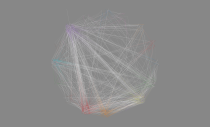A Day in the Life: Work and Home
People’s workdays tend to follow similar patterns. You wake up in the morning, get ready for the day, go to work for eight hours or so, and then go home. There are breaks in between. The 9 to 5, basically.
However, everyone’s day varies at least a little bit from everyone else’s. And, if you compare across different types of jobs, you start to see varying schedules. Some people work from home. Some work on the road. Some tend go to work earlier than others. Some work at night.
The animation below shows a simulated day for employed Americans in various occupations. It’s based on five years of data, 2011 to 2015, from the American Time Use Survey. Each dot represents a person moving between home and sleeping, work, and anywhere else. Dots turn non-gray when respondents work. Dots turn gray when they don’t work.
You might notice the percentages for each occupation never reach the full 100 percent. This is because not everyone in a given occupation category are ever working all at the same time. Also, the simulation includes people who were employed but for whatever reason didn’t work the day they were surveyed.
 A Day in the Life of Americans
A Day in the Life of Americans
I also simulated an average day for 1,000 Americans.
 Make a Moving Bubbles Chart to Show Clustering and Distributions
Make a Moving Bubbles Chart to Show Clustering and Distributions
I used a variant of this tutorial to make this chart.
Notes
- I used data from the American Time Use Survey, which is much easier to download using the American Time Use Survey Extract Builder maintained by the Minnesota Population Center at the University Minnesota.
- For sleeping, the ATUS keeps a person’s place private, which is why I combined states of being at home and sleep.
- “Somewhere else” includes traveling.
- See IPUMS for more details on each job category.
Become a member. Support an independent site. Make great charts.
See What You GetFlowingData is made possible by supporting members. Since 2007, I, Nathan Yau, a real person, have been analyzing and visualizing data to help more people understand and appreciate it in their everyday lives.
If you liked this or want to make similar data things, please consider supporting this small corner of the internet. You get unlimited access to visualization courses, tutorials, and extra resources. Thanks. — Nathan


